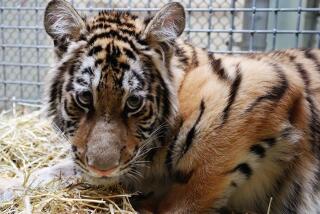Oldest big cat fossil found in Tibet
The oldest fossil of a previously unknown ancient leopard species, found in Tibet, is shaking the pantherine evolutionary tree, suggesting that big cats arose in Asia, not Africa, according to a new study.
During a 2010 expedition to Tibet, paleontologists led by the Natural History Museum of Los Angeles and USC discovered a large portion of skull and several intact teeth that they now attribute to a previously undescribed sister species to the modern snow leopard.
In all, they collected seven specimens from three individuals, and dated them to 4.1 to 5.9 million years ago - dialing back the clock on big cat evolution by as much as 2 million years, according to the paper, published online Tuesday in Proceedings of the Royal Society B.
Panthera blytheae, named for the daughter of longtime museum benefactors Paul and Heather Haaga of La Cañada Flintridge, was slightly smaller than the snow leopard and probably roamed the Tibetan plateau for several million years, dining on antelope, pika and blue sheep, according to paleontologist Zhijie Jack Tseng, lead author of the paper.
“We think that the snow leopard and this new cat probably represent a new lineage that was adapted to the high elevation environment of the Tibetan plateau,” said Tseng, a postdoctoral fellow at New York’s American Museum of Natural History who conducted the work while he was a doctoral student at USC.
Big cats have presented serious problems for paleontologists. The ancient ambush hunters’ preferred habitat proved unproductive for fossilization, leaving a poor record of a sojourn on Earth that exceeded that of modern man by millions of years.
Modern genetic sleuthing based on living species suggests that big cats diverged from other cats about 11 million years ago, then radiated into multiple species – lion, tiger, jaguar, leopard – about 6 million years ago.
“And that’s the story that the molecular biologists would tell,” Tseng said. “If you only looked at the fossil, it would suggest Africa. If you only looked at DNA, it would suggest Asia. So there was no new material to reconcile this difference until now.”
The team used the new fossils and other specimens to recalibrate the evolutionary tree and reconcile it with a DNA-based timeline. Although enormous gaps remain in the fossil record, the newly reconstructed tree lends weight to the theory that the cats arose and flourished in Asia.
“We have the oldest but not the most primitive [species], which is interesting because it means that there are more primitive cats to be found in the fossil record that would be older than the one we have now, but just haven’t been found,” Tseng said.
Panthera blytheae was named in honor of Blythe Haaga, daughter of longtime museum philanthropists Paul and Heather Haaga, who bid for the naming rights during a museum auction.
The former president of the museum’s board of trustees, now acting chief executive of NPR, Paul Haaga already had the smallest known dinosaur species named for his family – Fruitadens haagarorum. Heather Haaga suggested naming it for their daughter, Blythe, who was enthralled with snow leopards after receiving a plush toy replica as a child. She now is an improv comic and writer splitting her time between Chicago and Los Angeles. (The family timed the honor for Blythe Haaga’s 30th birthday in late October, though the paper did not publish until Tuesday.)
“He’s such a strong supporter of the museum,” said Xiaoming Wang, curator of vertebrate paleontology at the museum. “It’s a tradition among paleontologists to honor our colleagues in this way.”
Blythe Haaga found out about her belated birthday honor as she flew home from Chicago on Monday. Details of the significance of the find were closely held until publication. “Now I’m super honored,” she said when told of the study’s findings. “I was just honored before.”
The snow leopard, Blythe Haaga said, “was the stuffed animal that I loved, and therefore every book report was on snow leopards for a long time after that. It became my fascination for a while.”
The Tibet excavation team also hailed from the National Museum of Natural History, George C. Page Museum, Chinese Academy of Sciences, University of Alberta and Gansu Provincial Museum. It was funded by the National Science Foundation as well as the Natural History Museum of Los Angeles, which has made a casting of the fossil skull.







